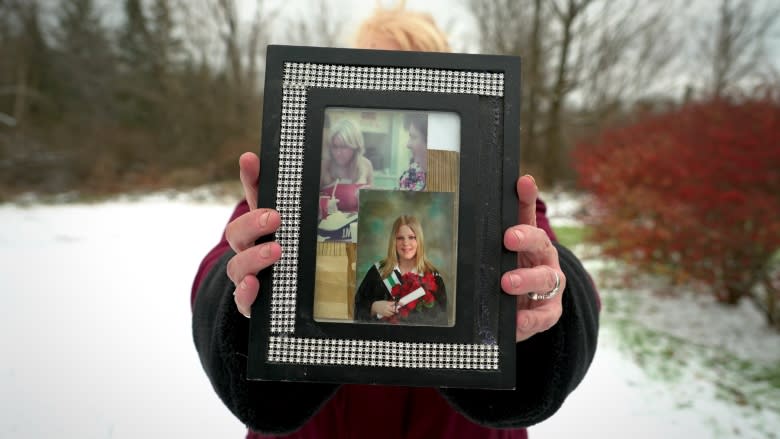'I just want my daughter back': Sex trafficking victims often caught in vicious cycle trying to escape
Her mind raced as she thumbed through her daughter's emails.
The rural Ontario mother knew her daughter had borrowed her phone while staying at her home that weekend, a visit that was cut short when the daughter abruptly left to meet a friend. Her Yahoo account was still logged in.
One message in particular jumped out: The confirmation email for a new classifieds post advertising sex services. There, online for anyone to see, were photos of the woman's 26-year-old daughter clad in revealing lingerie, offering sex in exchange for money and drugs.
She had already survived at least two stints in the dark world of sex trafficking. In 2016, she was held against her will at a hotel in Newfoundland, and was trafficked up and down Ontario's 401 corridor this October, from Barrie to Kingston to Orillia. In one tense moment, she was sold from one trafficker to another to settle a drug debt. In another, she had three guns held against her head.
CBC Toronto has withheld the woman's name, and that of her mother, for safety reasons.
"She was bought and sold, bought and sold, bought and sold," her mother recalls, her voice breaking.
So why, after all that, would her daughter go back?
Throughout Ontario, sex trafficking is a growing problem, with girls as young as 13 being recruited by pimps into a world of unpaid sex work. These teenagers and young women are trafficked across the province, forced to work in hotel rooms, roadside motels, and even suburban homes.
And, while concrete province-wide data doesn't exist, some experts estimate there are thousands of victims, many caught in a vicious cycle where they break free of their pimps, only to return weeks or months later.
The reasons why are complicated. From a patchwork assortment of support services to the deep-rooted psychological trauma experienced by victims, CBC Toronto has found there is a complex web of factors that lead women to return over and over to the clutches of sex trafficking, some as many as five times before breaking free.
Most victims girls, women 13 to 26
It's a situation Bruce Rivers knows well. He's the executive director of Covenant House Toronto, a youth homeless shelter with a rapidly growing sex trafficking unit and two bed spaces for victims.
The beds, Rivers says, are always taken, and the centre has helped more than 80 sex trafficking victims over the past year alone. There has also been a roughly 300 per cent increase in the number of people seeking services over the last few years, he adds.
The same trend is clear across the province. As CBC Toronto previously reported, Ontario's anti-trafficking director, Jennifer Richardson, estimates the number of trafficking victims in Ontario is in the thousands.
And in recent years, various police forces have made hundreds of arrests related to sex trafficking, including more than 100 men arrested by York Regional Police for "purchasing prostituted children" during a sting lasting from 2014 until earlier this year.
Most sex trafficking victims are local girls and women between 13 and 26, Rivers says, and they're often recruited by "Romeo pimps" on social media or at public places like shopping malls and playgrounds.
"Typically, the relationship will start as a romantic one — somebody who's proposing to be a boyfriend," he explains.
Then, the pimps ask the girls to perform sexual services on clients as a favour, and promise them the financial freedom to reach their dreams, like buying a car or condo.
But as the girls engage in more sex acts over a lengthy period, their pimps often threaten them with violence, take their phones away, and offer them hard drugs.
"All of these issues combine to make it really really tough for young women to get out of 'the game,'" says Rivers, referring to the moniker given to the sex trafficking world.
And, he says, it can take two to three years for girls to overcome the trauma of their time being trafficked.
It's also "not unusual" for women to come forward for help three to five times before they are able to fully escape, Rivers says.
'These girls are broken'
In the case of the 26-year-old sex trafficking victim whose mother spoke to CBC Toronto, this is at least her third time in "the game."
The woman speculates that a family friend's daughter, an escort, first introduced her daughter to the world of sex trafficking. And she believes her daughter's longtime drug use and mental health issues — including a diagnosis of bipolar disorder at age 15, and post-traumatic stress disorder in her 20s after her father's death by suicide — put her at risk.
Despite police involvement, she says her daughter keeps connecting with new pimps.
After her last stint being trafficked across the province, she says she brought her daughter to safety in late October. Then the young woman got in touch with Victim Services, a branch of the Ministry of the Attorney General which helps connect victims of crime with essential services.
She says Victim Services helped her daughter purchase clothing and connected her with counselling services, but nothing was finalized — and her mom claims they didn't hear any updates for several weeks. At that point, the 26-year-old vanished again.
"Clothing isn't going to fix this situation," her mother says.
Ministry spokesperson Emilie Smith wouldn't comment on specific cases, but stressed the province's commitment to helping victims of trafficking. The ministry, she says, provides crisis intervention services to victims "24-hours a day, seven-days a week" at the request of the police.
That support includes providing cellphones to some victims, referrals to community supports and services, emergency transportation to safe locations, and counselling.
Ontario also recently committed more than $18 million to programs to help prevent sex trafficking and support survivors — funding that was welcome news to 44 agencies across the province.
Despite the growing number of supports, escaping the vicious cycle is particularly challenging given the vulnerability of the women being trafficked, says Annalise Trudell, a manager at Anova, a sexual assault centre and women's shelter in London, Ont.
She says many victims are coping with addiction issues, or have been coerced into criminal activity. "It actually might be an almost informed decision to stay within that realm, as one of lesser harm," Trudell says.
The hold on victims is also "so strong psychologically," says Doug van der Horden, an adolescent care worker in the Kingston area who has spent a decade working with sex trafficking victims. Many victims feel they've ruined their lives, and have often lost most of their relationships and support networks.
"Within weeks," he says, "these girls are broken."
Help needed to navigate 'patchwork of services'
Given the complicated nature of the victims, van der Horden says no one agency can do everything.
But Trudell says there needs to be more help for survivors trying to navigate the province's "patchwork of services." Survivors need support for years, she says, and there should be designated case managers to help them navigate services like housing and counselling.
Rivers agrees that more co-ordination between services is essential, along with a national hotline for victims and people who suspect sex trafficking is happening in their communities.
As for the Ontario mom, she believes faster access to counselling and mental health support could be helpful for victims like her daughter. But, ultimately, she knows it's a decision she has to make for herself.
Sitting in her living room, the mom pulls out her phone to play a Facebook video. It was posted soon after her daughter left on Saturday, and shows the young woman on a bed with a man her mother believes may be her new pimp.
"That's the moneymaker," says the man, pointing to her on the bed. "That's the boss, that's the boss — she's the boss."
But she knows her daughter isn't "the boss," and isn't keeping a cent of the money she earns performing sex acts on countless men.
"I just want my daughter back," she says.
"I want her to know she's worth something. I want her to know it's OK. I want her to know the system, yes, is flawed — but I'm willing to get you help."





